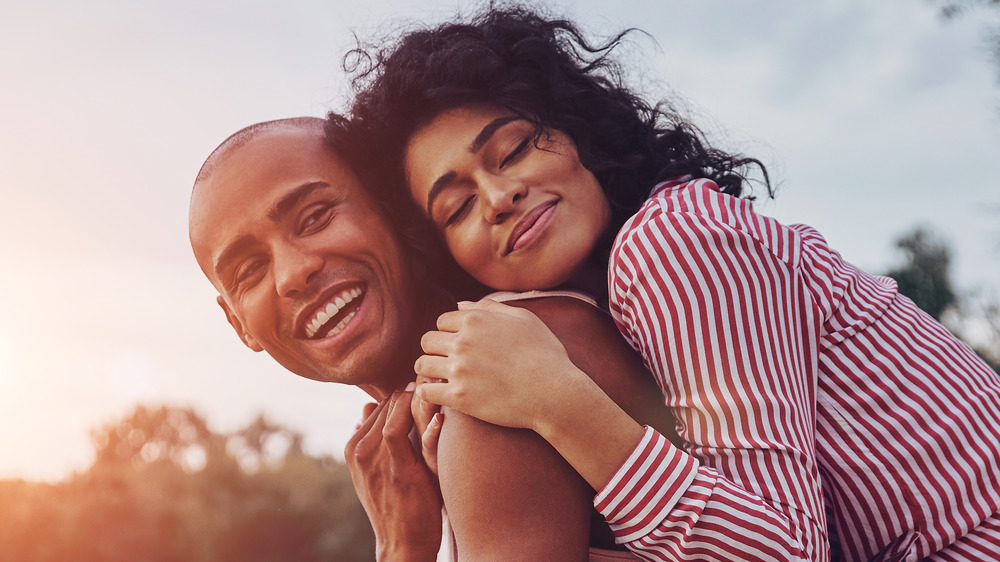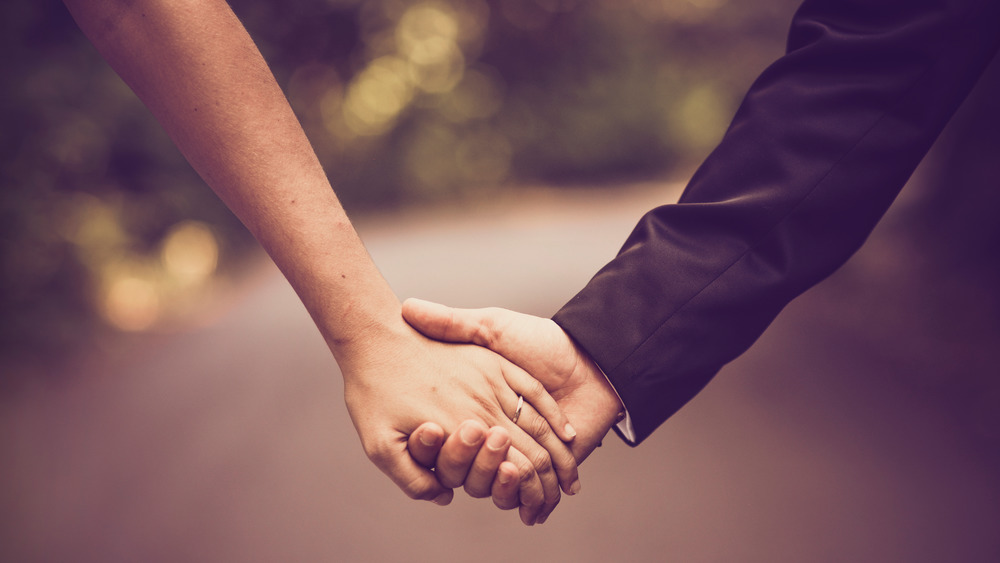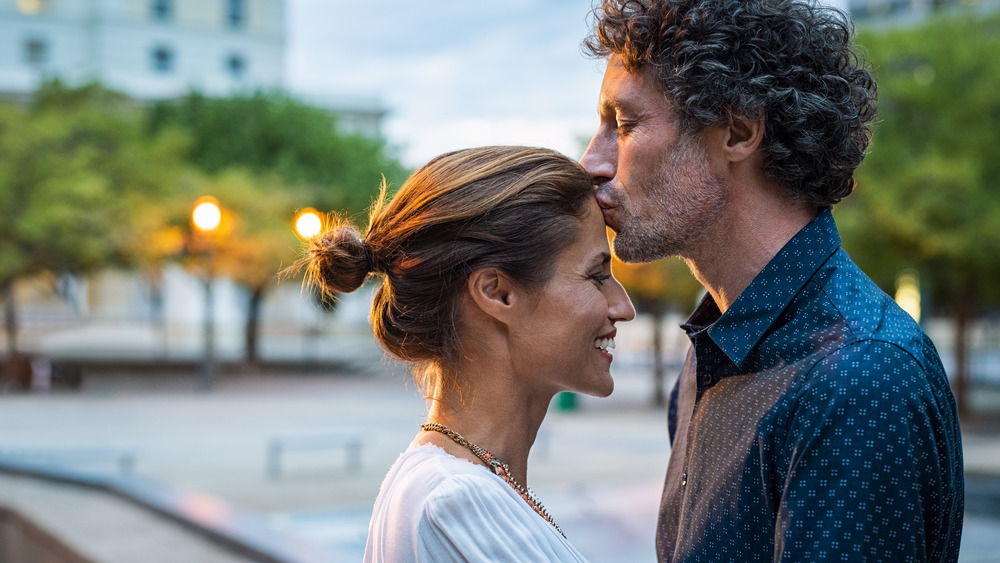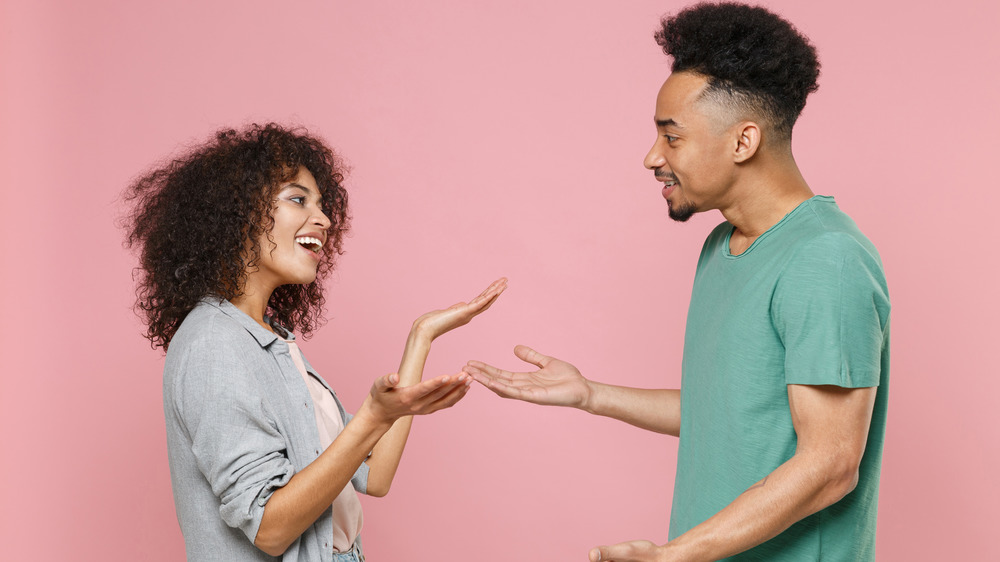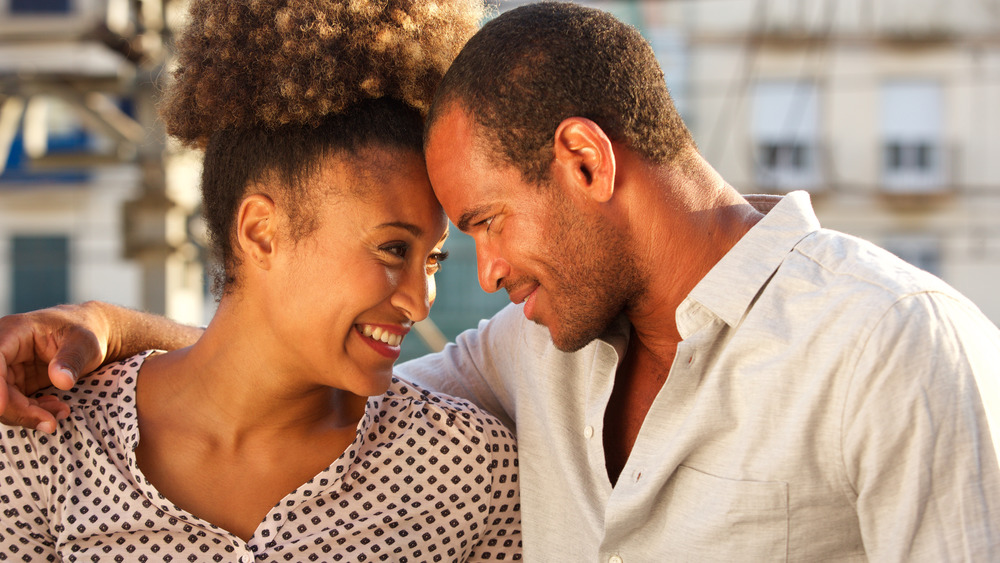What Your Body Language Really Says About Your Relationship
You may be familiar with your partner's language, and vice versa. You've adopted silly pet names, use your own catchphrases, and have running inside jokes. But in addition to this verbal love lingo you've got going on, your body could be expressing all sorts of other messages to your other half — and, FYI, to anyone else observing your actions.
Psychologist Mary Ann Mercer told Martha Stewart Weddings that body language "can reveal a lot on the status of your own relationship and, in particular situations, when you are addressing a topic with your significant other." It turns out that we could be giving both conscious and subconscious hints to the person we love the most — some positive, and others, well, not so much.
Everything from holding hands to the pace of your walk to whether or not you mirror movements can speak volumes. Want to get a better grasp on all the subtle, and not-so-subtle, physical couple cues you put on display? Read on to find out what you body language really says about your relationship.
There are different meanings behind types of handholding
Holding hands can be sweet and innocent. Just ask any kindergartener and they will tell you it is something they do daily with multiple different friends. But as an adult, when you and your romantic partner hold hands, it can take on a whole other meaning. Psychotherapist and relationship coach Toni Coleman explained to Women's Health that touching hands with a loved one can release oxytocin, a happy hormone that makes us feel warm and fuzzy on the inside. "It invokes a positive feeling about one another, so you both feel sexy and wanted. It's almost like foreplay," she said.
What's more, the way you hold hands can reveal more about your relationship (yes, there is more than one way to do it). Intertwined fingers could mean you strongly desire a meaningful connection, whereas a loose grip is common for cautious couples just starting a relationship. And when both of your hands are sandwiched between your partner's, it's like a loving embrace (via Women's Health).
This is what the arm sling means
You know that clichéd scene in practically every teenage rom-com ever, where the awkward boy puts the moves on a girl he likes by slinging his arm over her shoulder in a dark movie theater? That is the maneuver we are talking about. And while it can be a go-to first date flirtation, it generally means exactly what it looks like: The arm-reacher is "trying to be more physically close to you by drawing you into them," as Dr. Terri Orbuch, couple's therapist, professor, and author, told Women's Health.
BrightSide asked psychologists to explain an iteration of this arm-over-shoulder move and, interestingly, this body language isn't just for new couples. If Partner 1 puts their hand on Partner 2's shoulder, and Partner 2 puts theirs on Partner 1's waist (are you still with us here?), it most likely means that the couple is "very attached to each other." Furthermore, it indicates that they see themselves as equals in their relationship and in life.
This is what it means when you or your partner leads the way
Red flag alert! As interpreted by Cosmopolitan, a man who walks ahead of a woman — whether he realizes it or not — may "expect you to keep up with them." Couple's therapist Dr. Terri Orbuch agrees with this notion, telling Women's Health that when one half of a couple walks in front of the other, it generally gives a negative message.
"One person going ahead says they're in a rush, I wish you were going faster, and you're not as important to me as whatever I'm moving toward right now," Orbuch revealed. Furthermore, she said it can indicate a dynamic imbalance and an unhappy relationship.
But it is not always a bad sign; there are some exceptions. Orbuch continued, saying, "A lot of times men let women into a room first, or on to a line first, or in front of them if they're walking somewhere single file, and that's a sign of respect and caring."
Walking arm in arm may mean something different than you'd think
If a man tightly grips a woman's forearm, or vice versa, it can give off some awfully possessive vibes, reported BrightSide after consulting psychologists. On the other hand, when a couple walks with their arms linked (think of a bridesmaid and groomsman strolling down the aisle), it's not necessarily an amorous relationship. In fact, it is more of a hokey gesture — something you would see a parent and child do, as noted by couple's therapist Dr. Terri Orbuch.
However, it is possible that two people who link arms are, in fact, dating or married, and it may point to their dynamic. "For me it doesn't show closeness or happiness; it's a more formal or proper way of touching that's not as intimate," the expert told Women's Health. Hence why a bridesmaid and groomsman who may have never met before the rehearsal dinner look so awkward in those wedding photographs.
Crossed arms can have a couple different meanings
Crossed arms, cross attitude. Standing independently with your arms crossed over your body can signify a few things about your mood and your relationship. Psychoanalyst Babita Spinelli told Mind Body Green that this stance could mean that a person is "feeling anxious, resistant, tense, insecure, afraid, or responding to distress." It essentially creates a wall between two people, which can also indicate defensiveness. But it can also be a way for someone to self-comfort in stressful situations.
Since there are many ways to read this position, Dr. René Dailey, a communications professor, told the publication it is important to look at the whole picture to interpret someone's body language more readily. "For example, if the person we're talking to has their arms crossed but is smiling at us, leaning forward, and using friendly vocalics, then we likely don't interpret the arms crossed as showing negativity. But if the arms crossed are paired with frowns, distancing, and a furrowed brow, then collectively we probably conclude they are not favorable toward us."
A kiss on the forehead points to strong emotional intimacy
A hot and heavy tongue-thrusting make-out session certainly displays passion, but a simple forehead kiss can mean even more. Clinical sexologist Dr. Laurel Steinberg told Cosmopolitan, "The forehead kiss demonstrates a strong emotional intimacy." As explained by the magazine, "the warmth and pressure from someone's lips on your forehead stimulates the pineal gland, which releases chemicals that trigger joy and mental wellness." So, yes, this quiet, soft, and protective gesture can flood the recipient with a feeling of love and contentment and put a partner's absolute adoration and affection on display. And all without making bystanders feel totally uncomfortable (bonus!).
And while this sweet pucker-up is indicative of an "emotional closeness," locked lips are still pretty high on the list as well, and tend to point toward "sexual attraction," according to Steinberg. (But did you really need a sexologist to tell you that?)
It's a good sign if you and your partner mirror each other's movements
Is copying your partner the sincerest form of flattery? Is it mockery? Or is it something else entirely? According to WebMD, mirroring someone's stance, movements, or facial expressions "often builds trust and understanding between you" and a partner.
What's more, in a long-term relationship, it is usually something that happens subconsciously. Body language expert Tonya Reiman told Brides, "If you and your partner are holding hands and walking down the street, you are most likely walking on the same foot at the same speed. You're in tune with one another and matching your partner's gait." And this symbiosis and equalized dynamic can help promote the production of "love chemicals," further reenforcing your mutual trust and keeping you and your partner on the same page. "In the basic landscape of any relationship," Reiman continued, "we're drawn to the feeling of being in sync."
Standing together with open palms and wide stances signifies honesty
As it turns out, you may hold the key to a strong relationship in the palm of your hands — quite literally. Marriage and family therapist Jacob Koutz told Martha Stewart Weddings, "Research has found that showing the palms of our hands during conversation displays openness, honesty, and directness. Basically the things most people search for in a strong relationship."
Of course, it is also a good sign if you can't keep those open hands to yourself. Psychologist Mary Ann Mercer told the magazine that being touchy-feely with each other is also indicative of a strong and cohesive dynamic. She elaborated, saying, "Body language tells us about how someone we are interacting or talking to really feels or thinks on the inside, revealing even more than actual words do." So, yes, if your partner can't keep his or her hands off of you, it's probably a sign that he or she is very into you — physically, emotionally, or all of the above.
This is what it means when a couple leans in to their relationship
Lean in to your career if you want it to flourish. Lean in to your emotions to fully understand the scope of your feelings. And lean in to your partner to show that you are interested. As noted by psychologist Mary Ann Mercer, leaning toward your partner (or a prospective partner!) demonstrates that you care about what they are staying, doing, or thinking. Conversely, "leaning away means you may be disinterested in connecting with your partner while leaning your upper body toward your partner and lining up your face with theirs shows that you totally adore them," Dr. Mercer told Martha Stewart Weddings.
Couple's therapist Terri Orbuch also confirmed the meaning of this body language when speaking with Women's Health: "I can always tell when two people are interested in each other at a restaurant or café — when there is a table between them, but they're leaning in to talk to each other." That first date chemistry just can't be denied.
Touching your neck could be a sign of frustration or flirtation
If you fidget or grab at your neck while communicating with your significant other, it could point to strong, hard-to-navigate emotions — perhaps because of a fight or stressful situation. Body language expert Patti Wood told Good Housekeeping, "Oftentimes, touching the neck or throat indicates that someone is keeping something from another person. The throat is the gateway for words, and therefore it's one of the most vulnerable parts of the body."
But neck touching is not always a bad sign. It could indicate some early but self-conscious flirtation. "If the woman begins to play with her necklace, most likely she is a little nervous or timid," body language expert Joe Navarro noted in an article for Psychology Today. "The man may do the same thing by touching his neck or adjusting his collar." As the couple becomes more acquainted, Navarro continued, they will be more likely to expose more of their necks. Additionally, "self-grooming behaviors" (hair twisting, ear stroking, et cetera) can give the appearance that you are pining for a partner's attention, per WebMD.
The way you communicate with your hands says a lot
You are passionate and excited and expressive and, hey, it shows. Using your hands when you speak can give emphasis to what you are saying and help drive your message home. Body language expert Dr. Carol Kinsey Gorman explained to HuffPost, saying, "Gesture is really linked to speech, and gesturing while you talk can really power up your thinking. Gesturing can help people form clearer thoughts, speak in tighter sentences and use more declarative language."
Yes, typically talking with your hands is considered a good thing. But when those expressive paws of yours start making fast and "choppy" movements, it can express a "'my way or the highway' mentality," Susan Constantine, human behavioral expert and author, told Good Housekeeping. So next time your hands get out of hand while energetically (or angrily) arguing a point to your partner, take a deep breath and rein those babies in.
Unflinching eye contact can be romantic or unnerving
If you and your partner find yourselves in unintentional staring contests, it probably speaks to your love and trust for each other. As noted by WebMD, the ability to hold a "steady gaze" with a partner often means you feel at ease with each other. But if you're not entirely comfortable with that person, unflinching eye contact can feel, well, "awkward" if not "threatening."
Nevertheless, if you're in a committed relationship you should feel good about your ability to lock eyes and hold each other's attention. Body language expert Tonya Reiman told Insider, "Eye contact is incredibly intimate. Eye contact shows trust and emotional openness [and] tells the partner 'I am yours.' If your partner once offered up their eyes and suddenly stops, it's a red flag." What is more, if you notice your partner's eyes dilate when they look at you, it means they still get those oh-so amorous feelings (via WebMD).
Facial expressions can speak volumes
The eyes are the window to the soul. And if your partner's peepers roll to the back of their head when you make a comment or squint in dismay at the things you say, you may want to evaluate your relationship status. Of course, if they smile lovingly at you, that's a different story.
The facial expressions you make in reaction to each other reveal a lot about your dynamic as a couple. If your lips are tautly pressed together, it could make you appear dishonest, according to WebMD. Another conscious facial expression to avoid: smirking. When you make this haughty know-it-all face at your partner, it displays a sense of superiority, Susan Constantine, human behavioral expert and author, told Good Housekeeping. Furrowed brows are another bad sign. "When someone notices that their partner has 'judgy eyes,' they'll immediately feel defensive and put up a fight," Constantine said.
Your facial expressions should line up with your partner's, according to Constantine. "It's troubling when one person in the relationship doesn't show the correct emotional response given the situation. If your partner is stressed, your face should reflect that. The same goes for any emotion that your partner feels."

